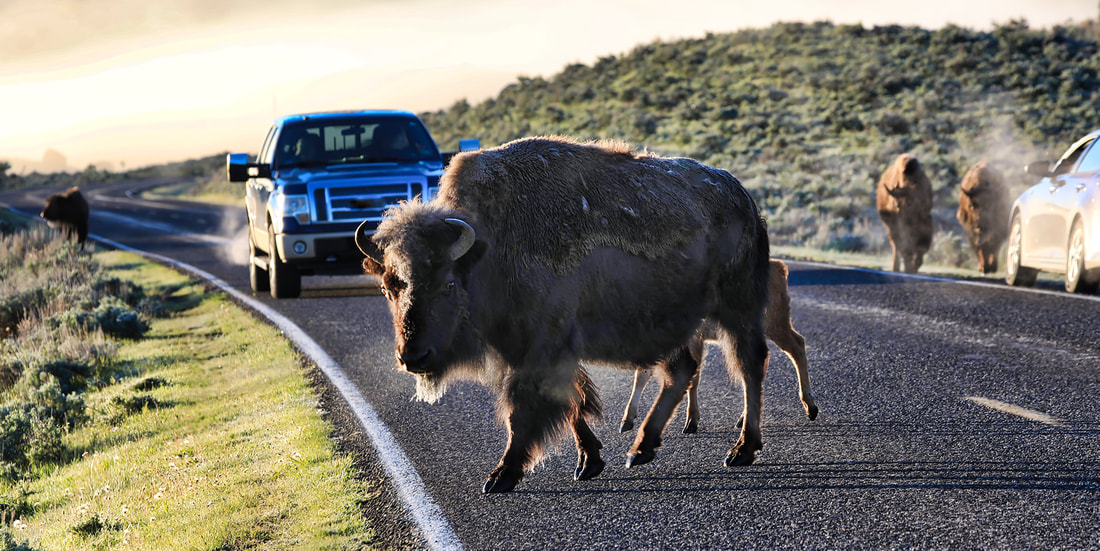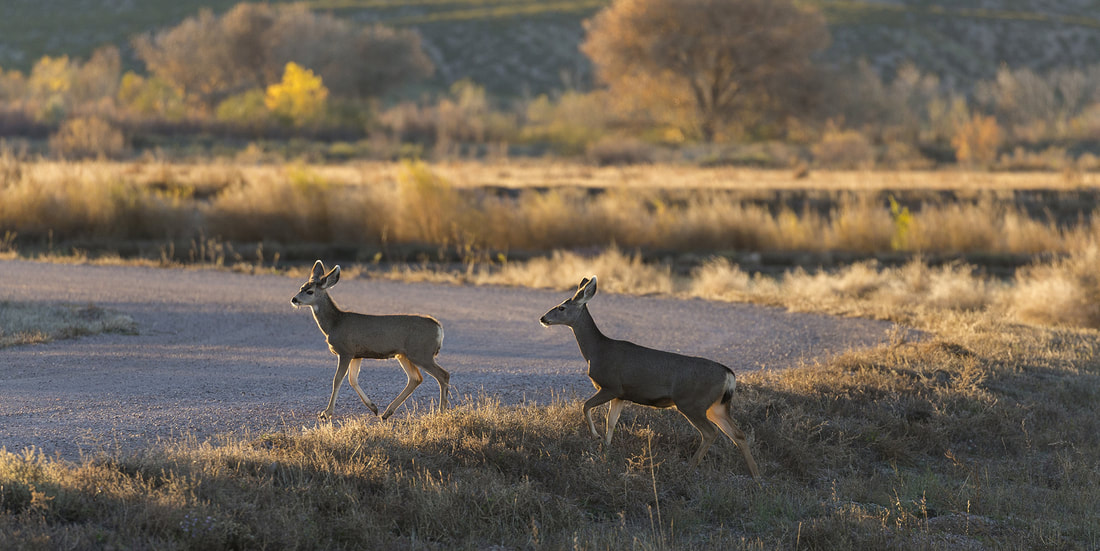Bison don’t just feast on spring greenery; they make it grow.
Large animals cover more miles each season than we ever imagined possible.
Science is yielding surprising discoveries into how wild animals move. Real-time GPS tracking systems paired with remote sensing technology reveal where and why animals travel across landscapes. Adventure Scientists is joining the effort by deploying a different type of tracker–the road cyclist. Now through 2022, thousands of cyclists will record wildlife sightings and roadkill along 11,000 miles of Montana roads to help highway and wildlife officials reduce wildlife-vehicle collisions. The publicly-available dataset should also provide insight into animal migrations in a state that boasts some of the most majestic wildlife in America.
Understanding wildlife movements is increasingly important for conservation and wildlife management. Climate change, habitat loss, and habitat fragmentation are three of the largest threats to wildlife around the globe, and each affects how and where animals move. Equipped with cutting-edge research, public and private land managers will be able to make informed decisions to try to mitigate these threats and restore once-connected wildlife habitats and corridors.
The Rocky Mountain West is leading the charge in migration research, with findings that are challenging long-held assumptions about animal movements, and informing land management decisions to help promote habitat connectivity. Below are major discoveries in the last decade of migration research in the Rocky Mountain West, including awe-inspiring revelations, fun facts to feed your inner geek, and paradigm-shifting discoveries that will shape the future of conservation and natural resource management.
2011 – Hiding in plain sight
Researchers discovered a mule deer migration spanning 150 miles, making it the longest known land-mammal migration within the continuous United States. The discovery made it onto the national stage, with coverage in National Geographic and the New York Times. The deer cross a patchwork of public and private land, traverse natural and man-made obstacles, and highlight the need for a new era of conservation strategies that protect wildlife corridors and connectivity at expansive scales. In 2012, Canadian researchers found pronghorn antelope that ducked fences, crossed railways, and traversed reservoirs to travel up to 260 miles from northern Montana across the border and into Saskatchewan and Alberta.
2011 – It’s about the journey, not the destination
Until recently, migrations were thought of as a means to an end, or an investment animals make to get from point A to point B. “Stopover ecology” is a research field that is turning this idea on its head. First documented in bird populations, the concept is simple: at key areas along a migration route, animals take a pit-stop to fuel up and save energy. In 2011, researchers showed that mule deer rely heavily on stopovers as a strategy to load up on nutrient-rich plants needed to make their long journeys. This new information identifies stopover sites as a significant consideration for conservation efforts.
2014 – If you feed them, they will come
For more than a century, federal and state governments have fed elk during the winter to prevent animals from starving and to keep them out of ranchers’ haystacks. These feedgrounds have changed when and how elk migrate. On average, fed elk leave their winter grounds later, spend more time at stopover sites, migrate further, and leave for their winter range sooner than their unfed counterparts. This study shows that a management decision made during one season can influence an animal’s behavior in another.
2016 – Surf’s up! Riding the “green wave”
The herbivorous, charismatic megafauna of the Rocky Mountain West are excellent surfers of what scientists are calling the “green wave.” As large herbivores (including moose, bighorn sheep, bison, and mule deer) migrate from their winter to summer grounds, they are “riding the green wave” of new sprouts, which have the highest nutritional value.
2016 – To underpass, or to overpass? That is the question
Wildlife underpasses and overpasses are designed to allow animals to cross roads safely. But not all animals like the same structures. When presented with an option, the vast majority of pronghorn prefer to take the high road, whereas mule deer prefer underpasses. This study highlights that vehicle-wildlife collisions and wildlife connectivity issues require a multi-faceted and strategic approach, incorporating strategies that will work for as many species as possible.
2018 – Bighorn sheep migration: nature vs. nurture?
Bighorn sheep aren’t born as migration experts – they learn through a process scientists call “cultural transmission.” By studying a population of newly introduced bighorn sheep, scientists were able to show that sheep learned when to leave and where to go, and shared that knowledge with other sheep over time. This research has implications for re-introducing species to areas where they have been extirpated, and it also has implications for conservation of sub-populations that take different migration routes.
2019 – Why wait for the wave when you can build it?
It turns out bison don’t ride the “green wave,” they engineer it. Intensive grazing by a herd of bison stimulates new sprouts to grow continuously throughout the growing season. In areas where bison graze, a sustained green wave provides nutrient-rich forage for an animal that needs to eat 24 pounds of vegetation per day.
2020 – Wildlife Corridor Construction Goes Green
Wildlife crossing structures have shown great success in reducing vehicle-wildlife collisions, but they are often constructed with energy-intensive materials such as steel and concrete, which are major contributors to greenhouse emissions. To avoid creating a problem while solving another, researchers have shown that fiber-reinforced polymer (FRP) composites can be a sustainable alternative, while still meeting the performance requirements and qualities of a steel and concrete crossing structure.
Want more cool animal migration facts? Check out the University of Wyoming’s Migration Initiative. Or check out this 2019 New York Times article about the longest land mammal migrations in world, including the incredible nearly 840-mile journey undertaken by caribou in the Yukon and Alaska.
What’s the next discovery? Help collect data to find out.
Adventure Scientists is looking for volunteer cyclists for a scientific research project that can help save wildlife and human lives. Volunteers will cycle sections of Montana roads at set periods throughout the summer and fall, using a simple phone app to record data on wildlife sightings and roadkill along their route. This information, collected across more than 11,000 miles of Montana roads, will help highway and wildlife officials understand where wildlife are crossing roads and identify wildlife-vehicle collision hotspots. Ultimately, this will inform state-wide efforts to reduce wildlife-vehicle collisions – an issue that results in more than 365 million animals killed, 29,000 humans injured, and $8.4 billion in damages incurred annually in the United States alone.
- Jesmer et al. 2011
- Poor et al. 2012
- Sawyer & Kauffman 2011
- Jones et al. 2014
- Merkle et. al 2016: Merkle, J.A., K.L. Monteith, E.O. Aikens, M.M. Hayes, K.R. Hershey, A.D. Middleton, B.A. Oates, H. Sawyer, B.M. Scurlock, M.J. Kauffman. 2016. Large herbivores surf waves of green-up in spring. Proceedings of the Royal Society B 283:20160456.
- Sawyer et al. 2016
- Jesmer et al.2018
- Geremia et al. 2019
- Bell et al. 2020


